Mira Survey: Top 9 Real-Life Ways Sex Ed Keeps Failing Americans
Do current sex education standards meet the needs of modern Americans?
New research from hormonal health company, Mira, suggests there may be some room for improvement.

In a recent Mira survey, over 1,500 Americans between the ages of 18-44 were asked about their perceptions and experiences with sex education.
The findings highlight 9 unique life experiences where Sex Education is falling short*, with trends emerging for males, females, Gen Zers, and Millenials.
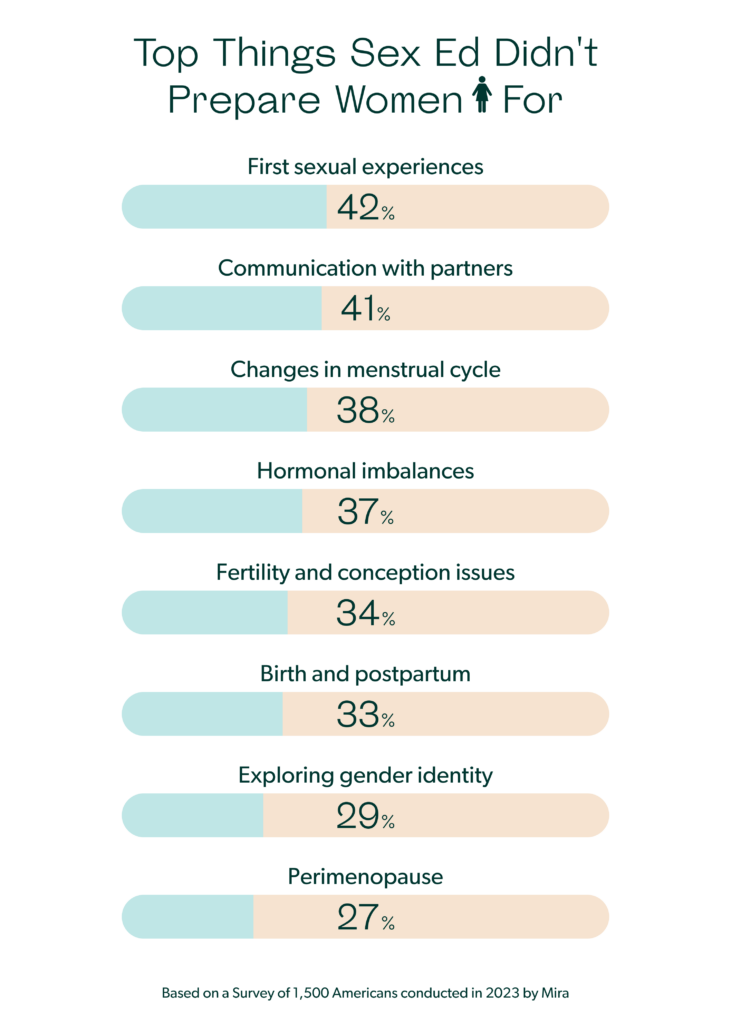
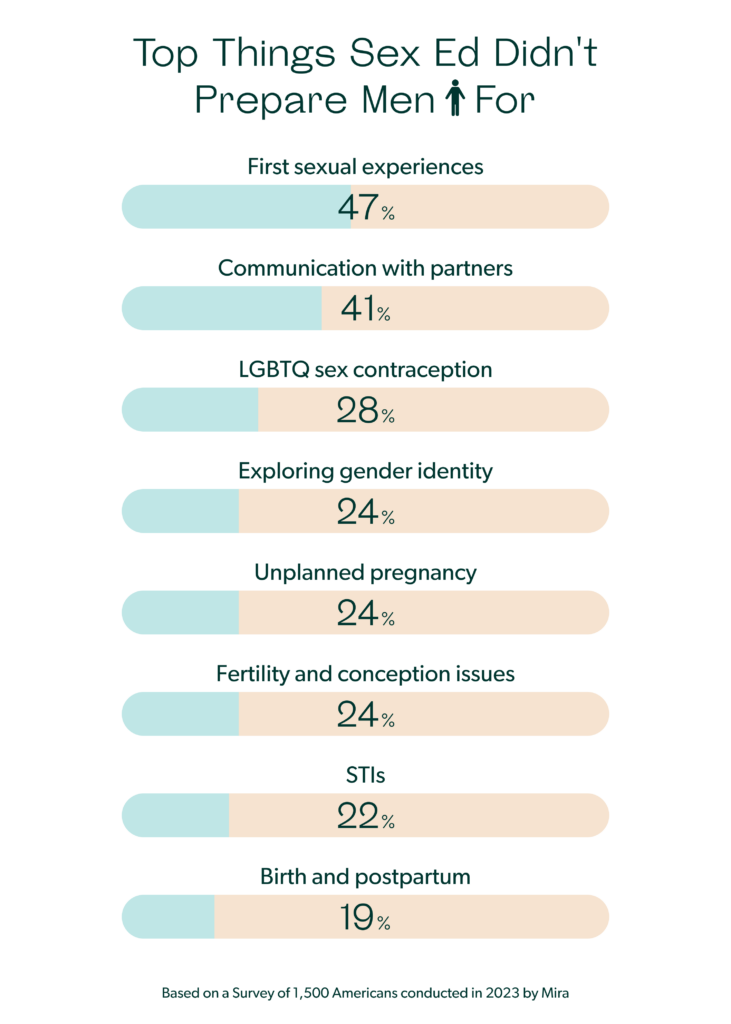
When asked if they felt prepared for a range of sexual health topics, the top 3 concerns of male participants were:
- First sexual experiences (47% felt unprepared)
- Communications with partners (41% felt unprepared)
- LGBTQ sex contraception (28% felt unprepared)
For all other issues, more than 70% of participants felt prepared and educated.
For female participants, the situation is much different, with many sharing that they felt unprepared for a number of different experiences.
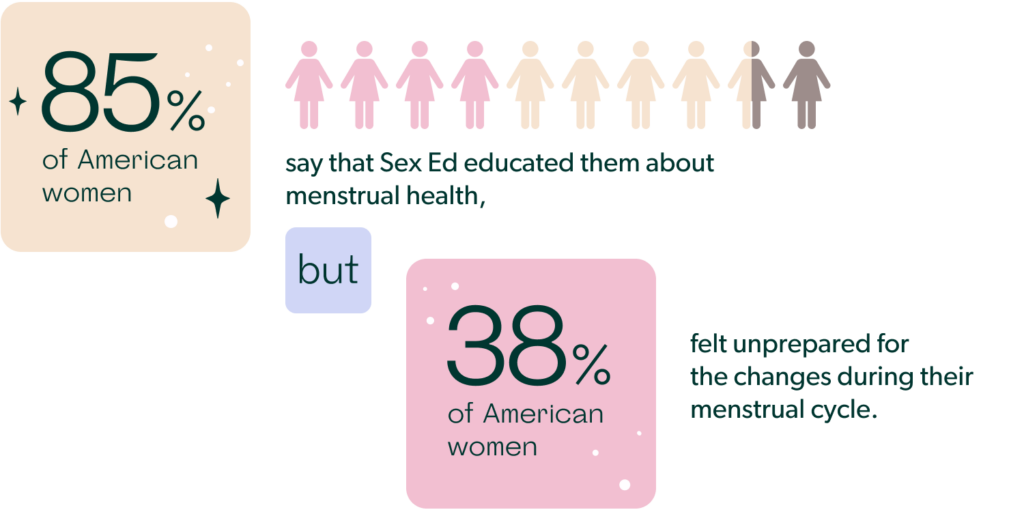
46% of Gen Z females and 36% of Millennial females shared that sex education did not prepare them for the changes to expect during their menstrual cycle

37% of Gen Z females and 33% of millennial females shared that they were not prepared to find out that getting pregnant can be a real struggle when they are ready. These numbers are significantly lower for male participants (21% of Gen Z males and 26% of Millennial males).
Other findings of note include:
- Only 32% of female participants reported learning about sexual pleasure during formal sex education classes, a stark comparison to the 51% of males who reported learning about sexual pleasure.
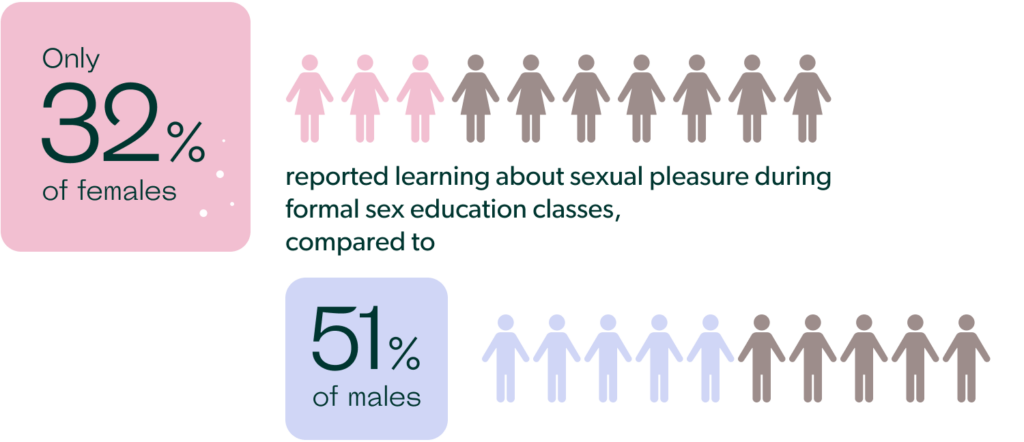
- 37% of all female participants shared that sex education didn’t prepare them for hormone imbalances.
- 33% of female participants felt that sex education did not prepare them for the postpartum period, while 27% felt that they were not prepared for perimenopause.
When it comes to hormones, nearly a third (30%) of all participants reported that they had learned nothing about sex hormones, with only 45% rating their knowledge of sexual health (including sex hormones) as “good”.

The consequences of this uncertainty can be seen in a previous Mira survey, which found that 65% of adult American women did not check their sex hormones for more than a year, with more than half of respondents admitting that their hormones are a “mystery” to them.
Another concerning finding is that only 21% of participants learned that sex can be painful, 40% did not receive any information about consent and respect, and only 16% had learned about asexuality.
“As the CEO of a company helping women understand their bodies, hormones, and fertility, I see a major gap in modern sex education. Women often lack knowledge about their cycles, hormones, and fertility. Many Mira customers spend much time searching for answers they should’ve learned in school. Our survey shows that 37% of women who received formal sex education feel unprepared for hormone imbalances, and 33% lack guidance on fertility issues. We urgently need to change the focus of sex education. Using tech and inclusive teaching, we can empower the young to make informed choices about their health and futures.” – Sylvia Kang, CEO and founder of Mira
Where do people get sex education?
According to the survey, Millennials and Gen Z are most likely to use the following as primary sources for sex education.
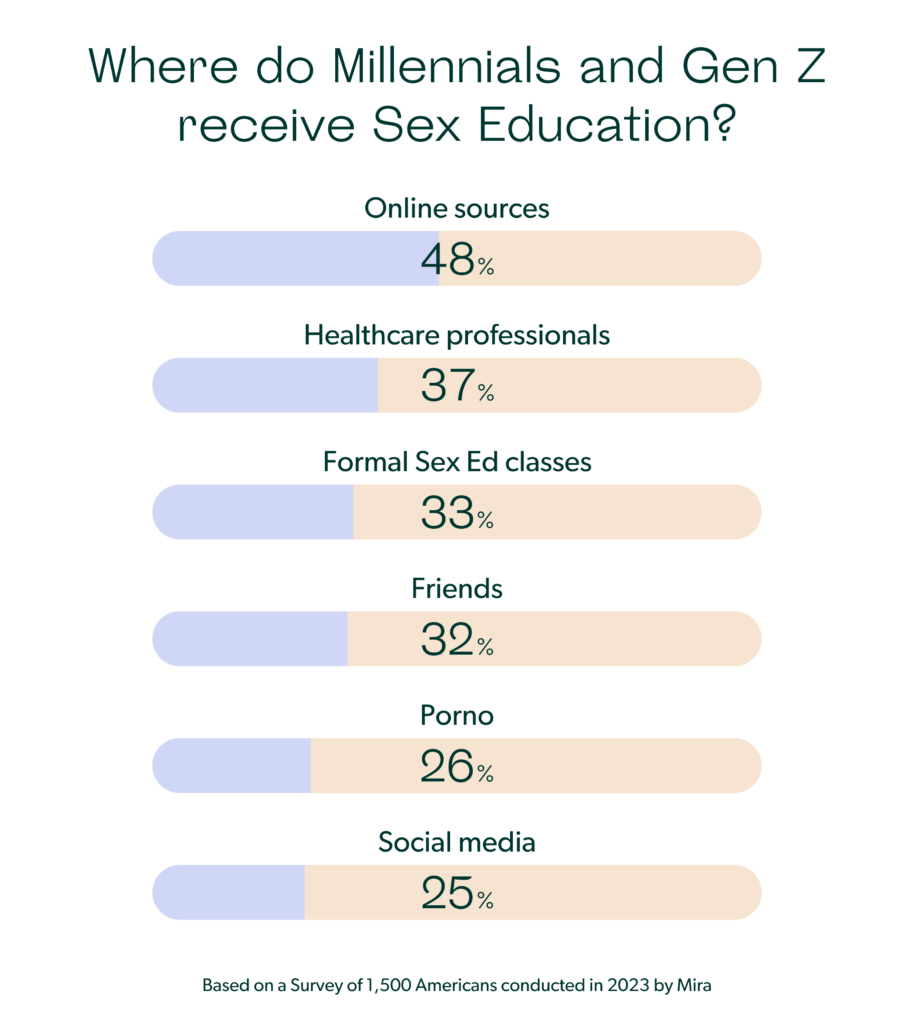
Although formal sex education may not provide a comprehensive education that prepares individuals for real life, respondents still claimed that they trusted it more compared to other sources.
The most trusted sex education sources include healthcare professionals (42%), formal sex ed classes (35%), and online sources such as blogs and websites (29%). Friends and peers come next at 18% followed by family members (17%). Other less trusted sources include online forums (12%), social media (10%), and movies & TV shows (8%).
When it comes to how these sources influence the way that sex and relationships are perceived, survey data show that pornography has the same impact on the perception of sex and relationships as formal sex education classes (26%). This is surprisingly higher than family (16%), social media (18%), TV shows (19%), healthcare professionals (21%), online sources (23%), and friends (23%).
How can formal sex education be improved?
We also asked participants about their ideas on how the approach to sex education can be improved for future generations.
Preparing real people for real life
In order to better prepare individuals for the challenges of real life, survey participants reported that the following themes should be incorporated into sex ed curriculum:
- Building healthy relationships and communication with a partner (57%)
- Exploring the emotional and psychological aspects of sexual wellness (52%)
- Avoiding misinformation and debunking stigmas around sex (46%)
For female participants specifically, there are two additional areas of high priority:
- Self-esteem, body image, and perception (45%)
- Hormonal imbalances, such as polycystic ovarian syndrome (PCOS) (43%)
Harnessing the power of technology
Parents are embracing technology as a primary source of sex education now more than ever.

41% of survey respondents proposed that implementing technologies during the learning process may make it more interactive and less uncomfortable for students, with 68% of individuals who have children (or want them in the future) sharing that they would embrace technology as a main source of sex education for their kids.
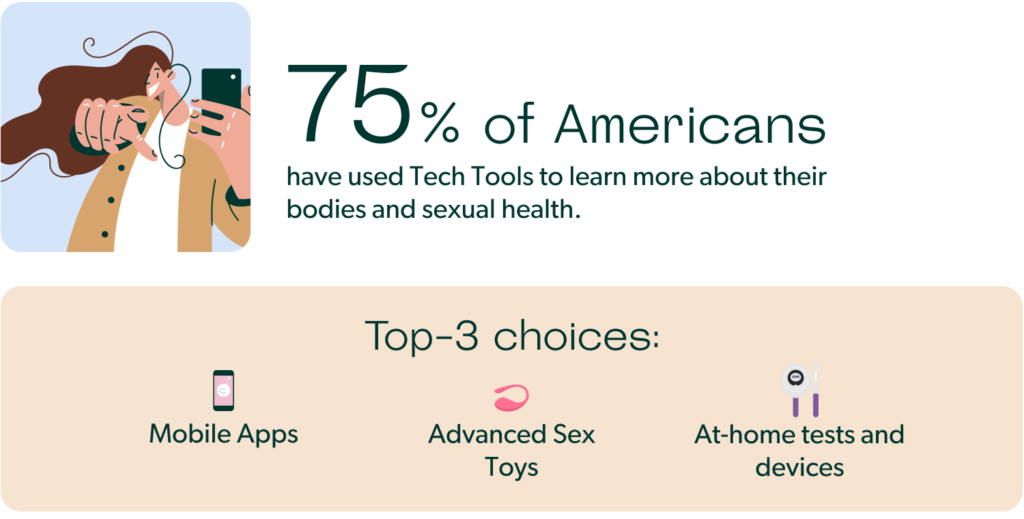
In terms of enhancing their understanding of their own sexual health, 75% of respondents shared that they have tried technology-based tools. The top three tools used include mobile apps (26%), tech-advanced sex toys (21%), and at-home tests (17%).
These tools can play a massive role in helping individuals gain much-needed clarity about their bodies.
For example, modern technologies such as reproductive hormone monitoring systems not only make it easier (and cheaper) to test and track hormone levels at home, but they also help individuals take charge of their reproductive health and plan for their future.
This is becoming increasingly important as individuals and couples wait to have children. In this survey, over half (53%) of respondents shared that they plan on having kids after the age of 30. Considering the fact that 30 is when fertility begins to decline, it is especially important for individuals to be educated about fertility and their personal fertility status as early as possible.
What Mira is doing to help?
✅ Providing an ecosystem of products that meets people where they are
At Mira, we are devoted to creating fertility solutions for all genders at all stages of the fertility journey.
One way that we do this is by empowering people to use revolutionary, lab-grade technology from the comfort of their homes.
By monitoring their reproductive hormones with the Mira App and Monitor on a daily basis, 70,000+ of our customers have all the tools they need to better understand their unique cycle patterns, get pregnant as efficiently as possible, and monitor their overall reproductive health as they age.

✅ Working with experts to create high-quality and inclusive educational resources
We know that when it comes to sexual education, access to quality resources can be lacking. In fact, over two-thirds (69%) of survey participants reported that they did not receive any formal sex education from an educational institution.
That’s why we work with a range of experts, doctors, and clinics to create educational resources about fertility, sexual health, and hormone health. These resources are available on our website and include a range of free webinars, guides, and blog articles.
✅ Helping to fill the gaps in fertility research
It’s no secret that there is a huge gap in medical research that limits the quality of healthcare for female individuals.
To help bridge this gap, our technology is used in research studies at Mount Sinai, the University of Melbourne, the University of British Columbia, Uppsala University (Sweden), University Hospital Zurich, Johns Hopkins University, and dozens of other institutions.
Final Thoughts
As the world around us continues to change, our approach to sex education also needs to change so that it meets the needs of our modern lives.
Based on the experiences of the Millennial and Gen Z respondents in this survey, the future of Sex Education should aim to incorporate the following themes: relationship building and communication, the psychological/emotional aspects of sexual wellbeing, consent and respect, LGBTQ+ sexual health and hygiene, hormone health, and how age can impact fertility.
New tools and technologies also have a role to play in helping individuals learn more about their bodies, take control of their sexual health, and make informed decisions for their future.
Mira’s Editorial Process
All content produced by Mira meets stringent editorial standards, ensuring excellence and accuracy in language and medical precision. Every piece undergoes thorough fact-checking and review by qualified professionals. Check out our full editorial process to learn more.




